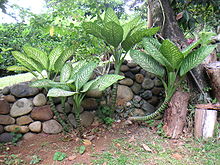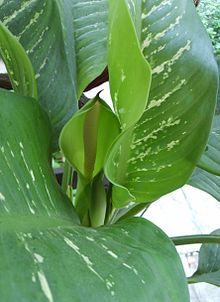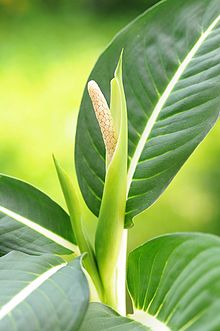- Dieffenbachia
-
Dieffenbachia (dumb cane) 
Dieffenbachia bowmannii Scientific classification Kingdom: Plantae (unranked): Angiosperms (unranked): Monocots Order: Alismatales Family: Araceae Subfamily: Aroideae Tribe: Dieffenbachieae Genus: Dieffenbachia Species See text.
Dieffenbachia (
 /ˌdiːfɨnˈbækiə/)[1] is a genus of tropical plants in the Family Araceae noted for their patterned leaves. Members of this genus are popular as houseplants because of their tolerance for shade. The common name is 'dumb cane' due to its poisoning effect on the throat due to raphides. The dieffenbachia was named by Heinrich Wilhelm Schott, the director of the Botanical gardens in Vienna, to honour his head gardener Joseph Dieffenbach (1796–1863).
/ˌdiːfɨnˈbækiə/)[1] is a genus of tropical plants in the Family Araceae noted for their patterned leaves. Members of this genus are popular as houseplants because of their tolerance for shade. The common name is 'dumb cane' due to its poisoning effect on the throat due to raphides. The dieffenbachia was named by Heinrich Wilhelm Schott, the director of the Botanical gardens in Vienna, to honour his head gardener Joseph Dieffenbach (1796–1863).Contents
Favourable conditions for houseplants
Dieffenbachia plants can grow outdoors in tropical climates, but specimens kept as houseplants must be kept indoors during most of the year outside the tropics. Temperatures below about 10˚C (40˚F) can kill the plant. The plant needs light but filtered sunlight through a window is usually sufficient. When the plant is brought home from the nursery, it will likely need repotting. The plant needs moderately moist soil. The soil should be fertilized with either regular liquid fertilizing or fertilizer pellets or spiky spikes. Leaves will periodically roll up and fall off to make way for new leaves. Yellowing of the leaves is generally a sign of problematic conditions, such as a nutrient deficiency in the soil. Dieffenbachia responds well to hot temperatures and dry climates.
Selected species
- Dieffenbachia amoena
- Dieffenbachia maculata
- Dieffenbachia seguine
Toxicity
The cells of the Dieffenbachia plant contain needle-shaped calcium oxalate crystals called raphides. If a leaf is chewed, these crystals can cause a temporary burning sensation and erythema. In rare cases, edema of tissues exposed to the plant have been reported. Mastication and ingestion generally result in only mild symptoms.[2] With both children and pets, contact with dieffenbachia (typically from chewing) can cause a host of unpleasant symptoms, including oral irritation, excessive drooling, and localized swelling.[3] However, these effects are rarely life-threatening. In most cases, symptoms are mild, and can be successfully treated with analgesic agents,[4] antihistamines,[5] or medical charcoal.[6] Gastric evacuation or lavage is "seldom"[6] indicated.[4] Jennifer S. Boyle, MD, PharmD, and Christopher P Holstege, MD, note that, "In a large retrospective study of 188 patients with plant oxalate exposure, all cases were determined to be minor and all resolved with minor or no treatment". [4] They also note that, "In patients with exposure to toxic plants, 70% are children younger than 5 years".[4]
Notes
- ^ Sunset Western Garden Book, 1995:606–607
- ^ Journal of Toxicology - Clinical Toxicology 29 (4): 485–91. 1991.
- ^ http://www.aspca.org/pet-care/poison-control/plants/dieffenbachia.html
- ^ a b c d "Toxicity, Plants - Caladium, Dieffenbachia, and Philodendron". emedicine. medscape.com. Updated: Dec 9, 2008. pp. 5. http://emedicine.medscape.com/article/1009003-overview. Retrieved 2009-03-17.
- ^ GN Lucas - Sri Lanka Journal of Child Health, 2008 - http://www.srilankacollegeofpaediatricians.com/pubs/Microsoft%20Word%20-%20CC%20de%20Silva%20Oration%20Plant%20poisonin.pdf
- ^ a b Human & Experimental Toxicology, Vol. 15, No. 3, 245-249 (1996) DOI: 10.1177/096032719601500310
References
- Schott, H. W. and Kunst, W. Z. (1829). Für Liebhaber der Botanik.
External links
Categories:- Araceae genera
- Garden plants
Wikimedia Foundation. 2010.


